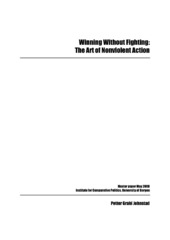| dc.description.abstract | Nonviolent collective action emerged during the last century as a potent tool for democratizationand the pursuit of freedom and human rights. Yet the phenomenon remains somewhatunderstudied, and our understanding of its dynamics far from complete. The paper attempts toaddress the lack of understanding by identifying causal factors that can explain the success orfailure of nonviolent protest. It approaches this question through a combination of threecomparative methodologies – in-depth qualitative case studies, Boolean comparison (QualitativeCase Analysis) and statistical analysis – examining a total of 29 cases of nonviolent actionthroughout the 20th century (with a brief foray into the 21st). The data set is constructed fromextant case studies and other secondary sources. The study investigates the causal impact ofregime legitimacy, regime and protest group violence, mass media freedom, and religiousauthority on protest outcome and identifies legitimacy and protest violence as particularlydecisive. A discussion of the implications of these findings for protest organizers is offered, andpredictions on their basis are made for the outcome of recent protests in Burma/Myanmar and ahypothetical Palestinian protest movement against the West Bank Wall. | en_US |
